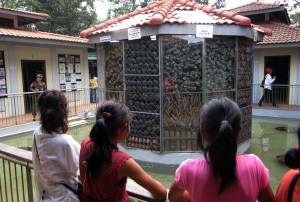Ever since Karen and I walked the Killing Fields outside Phnom Penh, we have been researching and learning more about Cambodian history.
How immediate are these events in today’s Cambodia? One morning on the hotel TV, we were startled to see images of Khmer Rouge security chief Kang Kek Iew (nicknamed “Duch”). The special court set up to try Khmer Rouge officers, which has been mired in political squabbles for years, finally got around to handing Duch a life sentence… decades after he oversaw the atrocities of Security Prison 21. More trials are set to begin soon, even as the defendants get old and die.
Although Pol Pot was driven out of Phnom Penh in 1979, the Khmer Rouge fought a guerrilla war for another two decades. Our tuk-tuk driver at Angkor Wat, Fickry, remembers his father building a bunker in the backyard. He recalls sitting in the bunker watching soldiers’ boots go by. “You never knew,” he said, “if they would turn around and come back for you”. The Khmer Rouge finally disintegrated with the death of Pol Pot in 1998. Whew, now we can move on, eh? Get this: many of the officials in the post-KR government had ties to the Khmer Rouge.
Then there are the land mines. Over the years, various armies tried to keep various people from going various places in Cambodia, leaving the landscape littered with land mines. And don’t forget that US President Richard Nixon (secretly) ordered over half a million tons of bombs be dropped on (neutral) Cambodia during the war in Vietnam. That left the country littered with unexploded ordnance, lying around in farmers’ fields, ready to go off if stumbled upon by a child or a farmer.
Made in Vietnam, China, the US and elsewhere, landmines and bombs still injure hundreds of people a year here. That’s down from 1,249 landmine casualties in 1998, thanks to an education campaign aimed at children.
Outside the tourist haven of Siem Reap, we visited the Cambodia Landmine Museum. There happened to be a free open house that weekend, so we were treated to an extensive tour and a screening of a new documentary, A Perfect Soldier.
The museum was founded by Aki Ra, who was present at the open house. Once, he was a child soldier for the Khmer Rouge, tasked with laying land mines. Now, he is an anti-mine crusader who has dedicated his life to making his homeland safe. At first, his methods were a bit unorthodox… as in, a stick and a screwdriver. There he was in the documentary footage, poking the ground with a stick, then unscrewing the underside of a live mine and cutting the wires. (I found myself holding my breath, even though I knew he’d be OK.)
More recently, he has gone legit, starting a non-profit that clears mines to international standards: no more defusing- now they use TNT to blow them up in place. As if on cue, this month’s National Geographic Magazine includes a lengthy article about Cambodia’s Healing Fields, prominently featuring Aki Ra.
He didn’t stop there, also founding a boarding school for at-risk children. They live in dormitories, learn subjects as diverse as English and art, and do odd jobs at the museum. The oldest children are now reaching college age, and amazingly the non-profit is able to offer them scholarships to university. Fundraising got a boost when Aki Ra was named a CNN Hero in 2010.

Aki Ra seems like a quiet, even shy, person. He hung around, smiled and posed for photos during the open house.
Cambodia is a troubled country, attempting to dig out from under the weight of history. That past might inspire only hopelessness and fear, if it weren’t for people like Aki Ra and his team. They are taking an active hand in writing the next chapter of Cambodia’s history.





